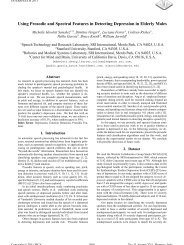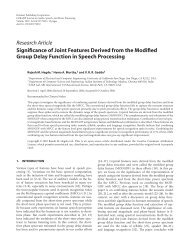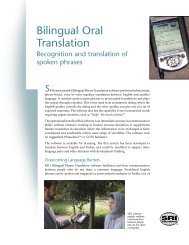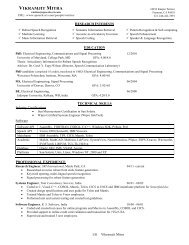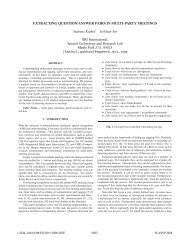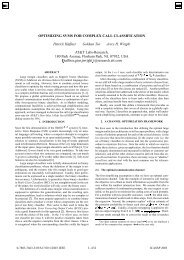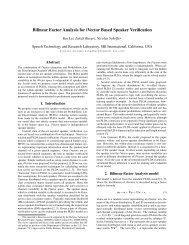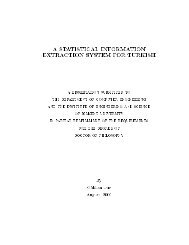SEMI-SUPERVISED LEARNING FOR PART-OF-SPEECH TAGGING ...
SEMI-SUPERVISED LEARNING FOR PART-OF-SPEECH TAGGING ...
SEMI-SUPERVISED LEARNING FOR PART-OF-SPEECH TAGGING ...
Create successful ePaper yourself
Turn your PDF publications into a flip-book with our unique Google optimized e-Paper software.
<strong>SEMI</strong>-<strong>SUPERVISED</strong> <strong>LEARNING</strong> <strong>FOR</strong> <strong>PART</strong>-<strong>OF</strong>-<strong>SPEECH</strong> <strong>TAGGING</strong> <strong>OF</strong> MANDARIN<br />
TRANSCRIBED <strong>SPEECH</strong><br />
Wen Wang1, Zhongqiang Huang2, Mary Harper2;3<br />
1SRI International, Menlo Park, CA 94025, USA<br />
2Purdue University, West Lafayette, IN 47907, USA<br />
3University Of Maryland, MD 20742, USA<br />
wwang@speech.sri.com,fzqhuang,harperg@purdue.edu<br />
ABSTRACT<br />
In this paper, we investigate bootstrapping part-of-speech (POS) taggers<br />
for Mandarin broadcast news (BN) transcripts using co-training,<br />
by iteratively retraining two competitive POS taggers from a small<br />
set of labeled training data and a large set of unlabeled data. We compare<br />
co-training with self-training and our results show that the performance<br />
using co-training is significantly better than that from selftraining<br />
and these semi-supervised learning methods significantly<br />
improve tagging accuracy over training only on the small labeled<br />
seed corpus. We also investigate a variety of example selection approaches<br />
for co-training and find that the computationally expensive,<br />
agreement-based selection approach and a more efficient selection<br />
approach based on maximizing training utility produce comparable<br />
tagging performance from resulting POS taggers. By applying cotraining,<br />
we are able to build effective POS taggers for Mandarin<br />
transcribed speech with the tagging accuracy comparable to that obtained<br />
on newswire text.<br />
Index Terms— POS tagging, Co-training, Self-training, Mandarin<br />
speech recognition, Active learning<br />
1. INTRODUCTION<br />
Part-of-speech (POS) tagging is a prerequisite for many advanced<br />
natural language processing tasks, for example, name entity recognition,<br />
parsing, and sentence boundary detection. Much effort has been<br />
expended to develop high-quality POS taggers, but the majority has<br />
been applied only on newswire text, largely because of the availability<br />
of labeled newswire training data. However, many tasks require<br />
applying POS taggers to a new domain with little or no manual annotations,<br />
for example, transcribed speech. Clark et al. [1] explored<br />
using co-training to bootstrap POS taggers using a small in-domain<br />
labeled seed corpus and a large set of unlabeled data. Although their<br />
work shows the effectiveness of co-training for improving POS tagging,<br />
their investigations were conducted within the newswire text<br />
genre. Mieskes and Strube [2] used four POS taggers originally<br />
trained on newswire text to tag a corpus of transcribed multiparty<br />
spoken dialogues. However, their work was focused on using manual<br />
corrections on the tags assigned by the taggers to evaluate the taggers<br />
and retrain them. To our knowledge, there has been little effort<br />
on exploring methods for applying semi-supervised learning methods<br />
like co-training to POS tagging on transcribed speech and evaluations<br />
of the tagging performance. Our work is aimed at helping<br />
to generate rich syntactic and semantic annotations for improving<br />
Mandarin broadcast news (BN) ASR and machine translation (MT)<br />
performance. To support building language models and translation<br />
models employing POS information for ASR and MT, we have been<br />
focusing on improving POS tagging on Mandarin BN transcripts. In<br />
the rest of the paper, Section 2 describes the co-training and selftraining<br />
algorithms, as well as example selection approaches used in<br />
co-training. Section 3 briefly describes the two POS taggers used in<br />
this work. Experimental results, discussion, and conclusions appear<br />
in Section 4.<br />
2. CO-TRAINING AND SELF-TRAINING<br />
2.1. General co-training algorithm<br />
Co-training was first introduced by Blum and Mitchell [3] as a<br />
weakly supervised method. It can be used for bootstrapping a model<br />
from a seed corpus of labeled examples, which is typically quite<br />
small, augmented with a much larger amount of unlabeled examples,<br />
by exploiting redundancy among multiple statistical models<br />
that generate different views of the data. Blum and Mitchell [3]<br />
showed that co-training is probably approximately correct (PAC)<br />
learnable when the two views are individually sufficient for classification<br />
and conditionally independent given the class. Abney [4]<br />
proved<br />
1Lh2 that a weaker independence assumption on the multiple classifiers<br />
than Blum<br />
S<br />
and Mitchell’s quite restrictive assumption could<br />
still allow co-training to work well. There has been much effort on<br />
investigating the efficacy of co-training in different domains and applications<br />
[4, 5]. The co-training algorithm developed by Pierce and<br />
Cardie [5] is presented in Algorithm 1 in this paper.<br />
Input:Sis a seed set of labeled data.<br />
Lh1is labeled training data forh1.<br />
Lh2is labeled training data forh2.<br />
Uis the unlabeled data set.<br />
Cis the cache holding a small subset ofU.<br />
2<br />
3 Train classifierh1onLh1<br />
4 Train classifierh2onLh2<br />
5 repeat<br />
6 Randomly partitionUintoCwherejCj=uandU0<br />
toLh2<br />
7 Applyh1;h2to assign labels for all examples inC<br />
8 Select examples labeled byh1and add<br />
9 Trainh2onLh2<br />
toLh1<br />
10 Select examples labeled byh2and add<br />
11U<br />
Trainh1onLh1<br />
U0<br />
12<br />
13 untilUis empty<br />
Algorithm 1: General co-training algorithm.
2.2. Example selection approaches for co-training<br />
In Algorithm 1, when calling the classifier that provides additional<br />
training data for the opposite classifier the teacher and the opposite<br />
classifier the student, since the labeled output from both classifiers<br />
h1andh2is noisy, an important question is which newly labeled<br />
examples from the teacher should be added to the training data pool<br />
of the student. This issue of example selection plays an important<br />
role in the learning rate of co-training and the performance of resulting<br />
classifiers. In this paper, we investigate four example selection<br />
approaches. The first is naive co-training, which simply adds all examples<br />
in the cache labeled by the teacher to the training data pool<br />
of the student. The single parameter that needs to be optimized (on a<br />
held-out set) for this example selection approach on the classification<br />
accuracy is the cache size,u.<br />
The second approach, agreement-based co-training [6, 1], is<br />
to select the subset of the labeled cache that maximizes the agreement<br />
of the two classifiers on unlabeled data. The pseudo-code for<br />
agreement-based example selection algorithm is presented in Algorithm<br />
2. The student classifier is the one being retrained and the<br />
teacher classifier is the one remaining static. During the agreementbased<br />
selection procedure, we repeatedly sample from all possible<br />
subsets of the cache, by first choosing the size of the subset and then<br />
randomly<br />
1Amax cmax<br />
choosing<br />
;<br />
examples from the labeled cache based on the<br />
size. In this algorithm,<br />
0<br />
ifh2is trained on the updatedLh2after<br />
adding output fromh1, then the most recent version ofh1is used<br />
to measure agreement and vice versa. Hence, this approach aims to<br />
improve the performance of the two classifiers alternatively, instead<br />
of simultaneously. Note that the agreement rate onU, denotedA,<br />
is the number of times each token in the unlabeled setUis assigned<br />
the same label by both classifiersh1andh2.<br />
Amax cmax<br />
Input:Cis a cache of examples labeled by the<br />
teacher classifier.<br />
Uis a set of examples, used for measuring agreement.<br />
2<br />
3 iter=1<br />
4 repeat<br />
5 Randomly samplecC<br />
c A<br />
6 Retrain student classifier usingcas additional<br />
data<br />
7A=the new agreement rate onU<br />
8 ifA>Amaxthen<br />
9<br />
10<br />
11 end<br />
12 iter++<br />
13 until iter=n<br />
14 returncmax<br />
Algorithm 2: Agreement-based example selection approach<br />
[1].<br />
Besides naive co-training and the agreement-based example selection<br />
approach, we proposed two different methods. One is to<br />
select the topnexamples with highest scores (based on a scoring<br />
function) when labeled by the teacher to add to the training pool of<br />
the student. This approach has been employed in many co-training<br />
applications. We denote it max-score. The underlying intuition is<br />
to select examples that are reliably labeled by the teacher for the<br />
student. However, Hwa’s work on active learning [7] has shown that<br />
accurately labeled examples may not always been useful for improving<br />
a classifier’s performance. Instead, examples with high training<br />
utility could satisfy this request. To combine accuracy and training<br />
utility, we defined another example selection criterion, which selects<br />
examples with scores within thempercent of top high-scoring labeled<br />
examples by the teacher and within thenpercent of bottom<br />
low-scoring labeled examples by the student. We denote it max-tmin-s.<br />
The intuition for this approach is that the newly labeled data<br />
should not only be reliably labeled by the teacher but also should<br />
be as useful and compensatory as possible for the student. During<br />
empirical evaluations of these example selection methods, control<br />
parameters, e.g.,nandm, in these approaches, are optimized on a<br />
heldout data set with respect to the performance of resulting classifiers<br />
after co-training.<br />
2.3. Self-training S<br />
algorithm<br />
We also compare the performance of co-training to self-training.<br />
There are a variety of definitions of self-training in the literature and<br />
we adopted that of Nigam Ghani [8]. The self-training algorithm<br />
is shown in Algorithm 3. Self-training in this work simply adds all<br />
examples in the labeled cache to the training pool in each iteration.<br />
Input:Sis a seed set of labeled data.<br />
Lh1is labeled training data forh1.<br />
Uis the unlabeled data set.<br />
Cis the cache holding a small subset ofU.<br />
1<br />
2 Train classifierh1onLh1<br />
3 repeat<br />
4 Randomly<br />
andU0partitionUintoCwherejCj=u<br />
toLh1<br />
Applyh1to assign labels for all examples in<br />
6<br />
5CSelect examples labeled byh1and add<br />
Trainh1onLh1<br />
8<br />
9 untilUis empty<br />
7U U0<br />
Algorithm 3: General self-training algorithm.<br />
3. TWO POS TAGGERS<br />
The two POS taggers we use in this paper are a Hidden Markov<br />
Model (HMM) tagger and a maximum-entropy (ME) tagger.<br />
3.1. H1: HMM tagger<br />
The HMM tagger used for this effort is a second-order HMM tagger<br />
initially developed by Thede and Harper [9]. This second-order<br />
HMM tagger, initially designed for English, used trigram transition<br />
probability estimations,P(tijti2ti1), and trigram emission probability<br />
estimations,P(wijti1ti). For estimating emission probabilities<br />
for unknown words (i.e., a word that does not appear in the<br />
training data), a weighted sum ofP(skijti1ti)was used as an approximation,<br />
whereskiis thek-th suffix of wordwi(the first suffix<br />
of wordwiis its last character). The interpolation weights for<br />
smoothing transition and emission probabilities were estimated using<br />
a log-based function introduced in [9]. In this work, we achieved<br />
improvement on Chinese newswire POS tagging accuracy after refining<br />
this model by: replacingP(wijti1ti)with context-enriched<br />
P(wijti1ti)12P(wi2jti2ti1)12for both known and unknown<br />
words; also, for unknown words, replacingP(wijti1ti)by the geometric<br />
mean ofP(ckijti1ti), whereckiis thek-th character of
the wordwi, for all of the characters of the wordwi(note that<br />
P(wi2jti2ti1)is calculated similarly). In Chinese, there is<br />
no inflection and derivation of words as in English. However, the<br />
last few characters of a Chinese word may still provide hints for<br />
propernouns, nouns, and verbs. We empirically compared the use<br />
of last few characters to all characters in a word for unknown word<br />
emission probability estimation and found that using all characters<br />
produced the best tagging accuracy and the use of last few characters<br />
also provides smaller but consistent improvement on the POS<br />
tagging accuracy.<br />
3.2. H2: ME tagger<br />
We built a maximum-entropy POS tagger that uses features from<br />
Ratnaparkhi’s ME tagger [10] adapted for Mandarin POS tagging.<br />
In our ME tagger, the context used for predicting the POS tag of a<br />
wordwiamong a sentencew1:::wnwith tagst1:::tnis defined<br />
ashi=fwi2,wi1,ti2,ti1,wi,wi+1,wi+2g. We modified<br />
the features for rare words in [10] by collecting a set of the most<br />
frequent last one character suffixes (i.e., the last character of a word)<br />
and last two character suffixes and created features for rare words<br />
with respect to including members in this set of rare-word suffixes,<br />
denotedS. The adapted features on the current historyhiare presented<br />
in Table 1. Different from the HMM tagger which is a joint<br />
model, the ME tagger uses a conditional model. Also, arbitrary features<br />
derived from the context can be easily added to the ME tagger,<br />
for example, word identities from either side of the target word. Besides<br />
this<br />
8wi<br />
theoretical comparison,<br />
ti1=Xandti=T<br />
in Section 4, we will empirically<br />
examine whether the two<br />
ti2ti1=XYandti=T<br />
taggers are sufficiently different based on<br />
their tagging output.<br />
wi1=Xandti=T wi2=Xandti=T wi+1=Xandti=T<br />
Table 1. Features on the<br />
wi+2=Xandti=T inSandti=T<br />
current historyhiused the ME tagger.<br />
Given the current history, a feature is indicator function of certain<br />
variables on the history.X,Y, andTin the table are instantiations<br />
of word and tag identities that can be automatically collected from<br />
the training data.<br />
Condition Features<br />
wiis rare wicontains a suffix<br />
wiis not rarewi=Xandti=T<br />
POS tags used in CTB 1 , we discriminated punctuation (POS tag as<br />
PU) by creating new POS tags for each distinct word type tagged as<br />
PU in CTB (e.g., PU-?). In total, we used 92 POS tags.<br />
The creation of the small seed corpus and evaluation test set<br />
for Mandarin BN transcripts is a non-trivial procedure. Since basically<br />
there was no hand-annotated POS-tagged Mandarin BN corpus<br />
available, we created one for this work using the following procedure:<br />
first, we selected the set of BN transcripts from the DARPA<br />
GALE program 2 Mandarin ASR/MT development test set, where we<br />
used the four dev show transcripts from the GALE Year 1 BN audio<br />
release. This text set, which includes about 17K words (about 79K<br />
characters), is our manual annotation corpus. Second, the HMM tagger<br />
was used to automatically assign POS tags to this corpus. Then,<br />
three annotators (all are native speakers of Mandarin with expertise<br />
on POS tagging) proof-read the pre-tagged corpus and fixed tagging<br />
errors. Since automatic word segmentation [11] was conducted on<br />
this corpus before the pre-tagging step, we also fixed transcription<br />
errors and word segmentation errors. Each annotator independently<br />
conducted manual annotations on the corpus and then an Emacs annotation<br />
tool adopted from LDC was used to highlight the differences<br />
between annotators’ decisions. The inter-annotator agreement<br />
from the first round was sufficiently high (estimated>0:7) 3 ,<br />
demonstrating that the automatically assigned tags can be reliably<br />
corrected by annotators. Differences between annotators were discussed<br />
and all disagreements appearing in the first round were resolved<br />
in the end. We extracted three disjoint sets from this tagged<br />
corpus: the first served as the small Mandarin BN seed corpus (400<br />
sentences, 8K words), the second was used as the POS-eval test<br />
set (400 sentences, 6K words), and the rest set (163 sentences, 3K<br />
words) was used as a heldout set for optimizing parameters for cotraining,<br />
for example,nandmfor the max-t-min-s approach.<br />
The large set of unlabeled data includes the following sources:<br />
the HUB4 1997 Mandarin BN acoustic transcripts, the LDC Chinese<br />
TDT2, TDT3, TDT4 corpora, GALE Year 1 Quarter 1, 2, and Interim<br />
release of BN audio transcripts, Multiple-Translation Chinese<br />
Corpus part 1, 2, and 3, and Chinese Gigaword corpus. Note that the<br />
word segmentation algorithm presented in [11] was applied and the<br />
unlabeled data was segmented into 750M words (34M sentences) of<br />
text.<br />
Table 2. Comparison of the average 10-fold cross-validation tagging<br />
accuracy (%) on CTB from the HMM tagger and ME tagger. Known<br />
word, unknown word, and overall accuracies are included.<br />
Tagger Known Unknown Overall<br />
HMM 95.0 76.2 94.3<br />
ME 94.2 75.1 93.1<br />
4. EXPERIMENTS<br />
4.1. Data<br />
In this paper, the data set of labeled examples is a text corpus with<br />
each sentence annotated with POS tags. For Mandarin POS tagging,<br />
the most recently released Chinese Penn Treebank 5.2 (denoted<br />
CTB, released by LDC) contains around 500K words, 800K characters,<br />
18K sentences, and 900 data files, including articles from the<br />
Xinhua news agency, Information Services Department of HKSAR,<br />
and Sinorama magazine (Taiwan). The format of CTB is similar to<br />
the Penn English Treebank and it was carefully annotated. In this<br />
work, we first compare the performance of the two POS taggers on<br />
the CTB corpus, and for self-training and co-training, we always include<br />
CTB in the initial training pool for each tagger. Among the 33<br />
4.2. Co-training and self-training results<br />
Table 2 presents the averaged 10-fold cross-validation tagging accuracy<br />
from the two taggers on CTB. The HMM tagger outperforms<br />
1 The part-of-speech tagging guidelines for the Penn Chinese Treebank<br />
(3.0), http://www.cis.upenn.edu/ chinese/posguide.3rd.ch.pdf.<br />
2 The goal of the GALE program is to develop computer software techniques<br />
to analyze, interpret, and distill information from speech and text in<br />
multiple languages.<br />
3 The Kappa Statistics is an index which compares the agreement against<br />
that which might be expected by chance. Kappa can be thought of as the<br />
chance-corrected proportional agreement, and possible values range from +1<br />
(perfect agreement) via 0 (no agreement above that expected by chance) to<br />
-1 (complete disagreement).
the ME tagger, but both taggers are competitive on tagging newswire<br />
text. We examined the output of the two taggers on CTB and found<br />
that they made quite different errors. Hence, we hypothesized that<br />
the two taggers are sufficiently different to allow co-training to produce<br />
reasonable performance. Before conducting co-training or selftraining,<br />
we found when using the two taggers trained on the entire<br />
CTB corpus to predict tags on the POS-eval test set, none of them<br />
gave satisfactory performance, as shown in Table 3. After adding<br />
the small seed corpus for training, the accuracy for both taggers was<br />
improved by about 10% absolutely. These results demonstrate the<br />
significant mismatch on style and word use between the newswire<br />
and BN genres and the importance of using a high quality in-domain<br />
seed corpus for semi-supervised training. However, this tagging performance<br />
is still unsatisfactory.<br />
Table 4 shows that both self-training and co-training significantly<br />
improve the performance of the two taggers over directly<br />
training on CTB plus the seed corpus, with co-training strongly outperforming<br />
self-training, even for naive co-training. Note for selftraining<br />
and co-training carried out in these experiments, we used<br />
cache size as 10K sentences. Among the four example selection<br />
approaches, the agreement-based approach yields the best accuracy<br />
from resulting taggers. Between agreement-based co-training and<br />
naive co-training, consistent with the findings from Clark et al. [1],<br />
agreement-based co-training is superior to naive co-training, since<br />
at each iteration this approach dynamically selects the examples that<br />
can improve the agreement rate and rejects ones that cannot fulfill<br />
the goal. In contrast, naive co-training adds all new examples in<br />
the cache which might accumulate noise during learning. On the<br />
other hand, the number of iterations of retraining that the agreementbased<br />
approach requires is generally an order of magnitude larger<br />
than that of naive co-training. Interestingly, the max-t-min-s approach<br />
proposed in this work produces comparable performance to<br />
the agreement-based method. Considering this approach is much<br />
more computationally efficient than the agreement-based approach,<br />
it might be promising to explore in other co-training tasks. Also,<br />
Table 4 demonstrates that max-t-min-s approach outperforms maxscore.<br />
This shows that although max-t-min-s might let in many examples<br />
with errorful labels, the training utility of these examples for<br />
the student outweights the cost of errors introduced by these examples<br />
into the training data pool of the student. This observation of<br />
importance of training utility is consistent with the finding in active<br />
learning.<br />
By applying co-training, we have achieved 5% to 7% relative<br />
improvement and 4.5% to 6% absolute improvement on POS tagging<br />
accuracy on Mandarin BN data by employing a quite small seed<br />
corpus of labeled data and a large amount of unlabeled data. Cotraining<br />
also reduces the discrepancy between the two taggers and<br />
the best resulting POS tagging accuracy on the Mandarin BN POS<br />
evaluation test set is 94.1%, comparable to the 94.3% POS tagging<br />
accuracy we achieved on the newswire based CTB corpus using the<br />
HMM tagger 4 . We also found that we never obtained performance<br />
degradation from co-training, regardless of the number of iterations<br />
conducted. This observation is also consistent with the findings from<br />
Clark et al. [1] on the English newswire domain.<br />
In conclusion, we have shown that co-training can be effectively<br />
applied to bootstrap POS taggers for tagging transcribed speech by<br />
combining labeled and unlabeled data. The agreement-based example<br />
selection approach outperforms naive co-training while a more<br />
computationally efficient approach proposed in this paper, which incorporates<br />
the idea of maximizing training utility from sample sec-<br />
4 We achieved 94.8% POS tagging accuracy when applying co-training<br />
for the two taggers on CTB.<br />
tion, performs comparably to the agreement-based method. In future<br />
work, we will carry out further investigations on example selection<br />
approaches, relations between the size of the manually labeled seed<br />
corpus and performance of different co-training setups, and effective<br />
combination of co-training and active learning. We will also apply<br />
co-training for POS tagging (and parsing) on more difficult genres<br />
like spontaneous speech.<br />
Table 3. Comparison of the tagging accuracy (%) of the HMM tagger<br />
and ME tagger when trained on the entire CTB corpus and the<br />
additional Mandarin BN seed corpus and tested on the Mandarin BN<br />
POS-eval test set. Known word, unknown word, and overall accuracies<br />
are included.<br />
Tagger Known Unknown Overall<br />
HMM CTB 80.0 69.2 79.0<br />
CTB+seed 90.5 75.1 89.6<br />
ME CTB 79.2 66.8 78.5<br />
CTB+seed 89.2 74.0 88.1<br />
Table 4. Overall POS tagging accuracy (%) on the Mandarin BN<br />
POS-eval test set after applying self-training and co-training.<br />
Training Condition<br />
Tagger<br />
HMM ME<br />
Initial (i.e., CTB+seed) 89.6 88.1<br />
self-training 90.8 90.2<br />
co-training naive 91.9 91.8<br />
agreement-based 94.1 94.1<br />
max-score 93.2 93.1<br />
max-t-min-s 94.1 93.9<br />
5. ACKNOWLEDGEMENTS<br />
This material is based upon work supported by the Defense Advanced Research<br />
Projects Agency (DARPA) under Contract No. HR0011-06-C-0023.<br />
Any opinions, findings and conclusions or recommendations expressed in<br />
this material are those of the authors and do not necessarily reflect the views<br />
of DARPA. The authors thank Heng Ji for her work on manual POS annotation<br />
and Kristin Precoda for useful discussions regarding its content.<br />
6. REFERENCES<br />
[1] S. Clark, J. Curran, and M. Osborne, “Bootstrapping POS taggers using unlabelled<br />
data,” in Proceedings of CoNLL, Edmonton, Canada, 2003, pp. 49–55.<br />
[2] M. Mieskes and M. Strube, “Part-of-speech tagging of transcribed speech,” in<br />
Proceedings of LREC, Genoa, Italy, 2006.<br />
[3] A. Blum and T. Mitchell, “Combining labeled and unlabeled data with cotraining,”<br />
in Proceedings of COLT, 1998.<br />
[4] S. Abney, “Bootstrapping,” in Proceedings of ACL, 2002.<br />
[5] D. Pierce and C. Cardie, “Limitations of co-training for natural language learning<br />
from language datasets,” in Proceedings of EMNLP, 2001.<br />
[6] S. Dasgupta, M. Littman, and D. McAllester, “PAC generalization bounds for cotraining,”<br />
In T. G. Dietterich and S. Becker and Z. Ghahramani, editors, Advances<br />
in Neural Information Processing Systems, MIT Press, vol. 14, pp. 375–382, 2002.<br />
[7] R. Hwa, “Sample selection for statistical grammar induction,” in Proceedings<br />
of Joing SIGDAT Conference on EMNLP and VLC, Hongkong, China, 2000, pp.<br />
45–52.<br />
[8] K. Nigram and R. Ghani, “Analyzing the effectiveness and applicability of cotraining,”<br />
in Proceedings of CIKM, 2000.<br />
[9] S. M. Thede and M. P. Harper, “A second-order Hidden Markov Model for partof-speech<br />
tagging,” in Proceedings of ACL, 1999, pp. 175–182.<br />
[10] A. Ratnaparkhi, “A maximum entropy model for part-of-speech tagging,” Proceedings<br />
of the Conference on Empirical Methods in Natural Language Processing,<br />
pp. 133–142, 1996.<br />
[11] M.-Y. Hwang, X. Lei, W. Wang, and T. Shinozaki, “Investigation on mandarin<br />
broadcast news speech recognition,” in Proceedings of ICSLP, Pittsburgh, 2006,<br />
pp. 1233–1236.



